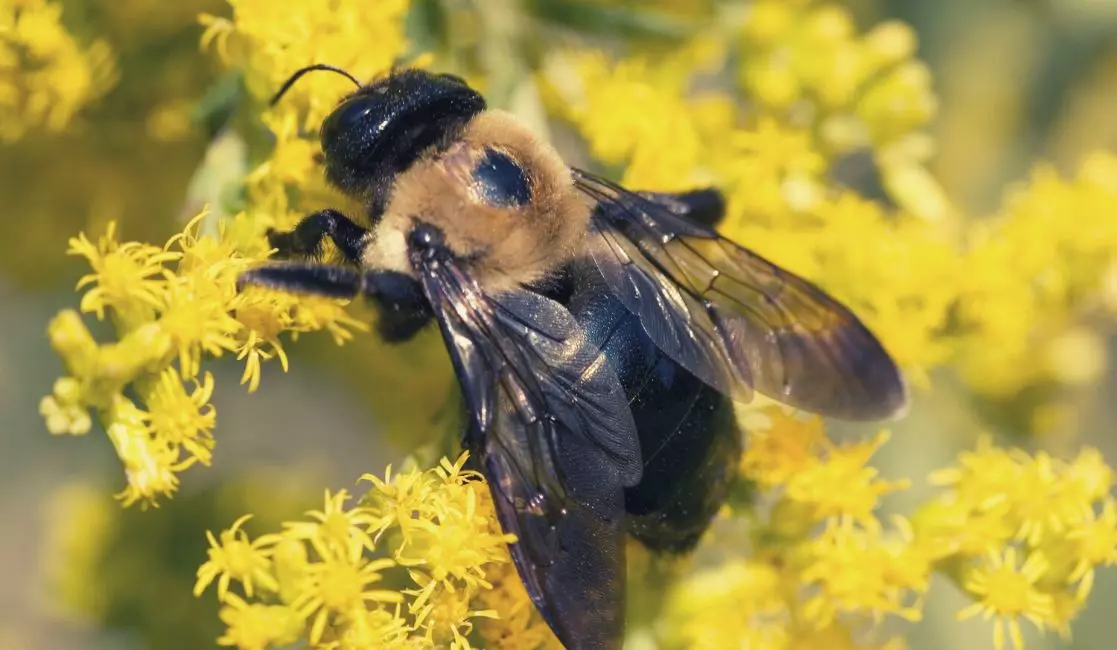Carpenter Bee Extermination & Control Service in Bowmanville
How Carpenter bees damage properties
Boring into wood: Carpenter bees create nests by drilling perfectly round holes into wooden structures such as eaves, siding, decks, fences, and other wooden components of buildings. The entrance holes are usually about 1/2 inch in diameter and are often found on the underside of wood surfaces.
Tunneling: Once inside the wood, carpenter bees create tunnels or galleries. They extend these tunnels by chewing through the wood, which weakens the structural integrity of the affected wood.
Multiple nests: Female carpenter bees can reuse existing tunnels or create new ones, leading to the accumulation of multiple nests within the same wooden structure. Over time, this can cause significant damage if left untreated.
Wood decay: Moisture can enter the tunnels created by carpenter bees, leading to wood decay and further weakening the affected areas. This can result in additional structural damage and potential safety hazards.
Secondary infestations: Other wood-damaging pests, such as woodpeckers or fungi, may be attracted to the holes and weakened wood created by carpenter bees. Woodpeckers may further enlarge the holes while searching for carpenter bee larvae, exacerbating the damage.

Structural damage caused by Carpenter bees
Weakening of wood: Carpenter bees excavate tunnels inside wood to create their nests. As they chew through the wood, they remove material and weaken its structural integrity. Over time, this can lead to significant damage, especially if multiple nests are present.
Nest expansion: Female carpenter bees can reuse existing tunnels or create new ones adjacent to existing ones. This expansion of nests can result in larger areas of weakened wood, increasing the risk of structural damage.
Moisture penetration: The entrance holes created by carpenter bees can allow moisture to enter the tunnels. This moisture can contribute to wood decay and rot, further compromising the structural stability of the affected wood.
Woodpecker damage: Woodpeckers are attracted to carpenter bee larvae and will often peck at the wood to access them. This can cause additional damage, including enlarged holes and splintering of the wood, which can weaken the structure further.
Secondary pests and fungi: The presence of carpenter bees and their tunnels can attract other wood-damaging pests like termites or carpenter ants. Additionally, the moisture and decay resulting from carpenter bee activity can create an environment conducive to fungal growth, leading to additional wood decay and structural problems.
Diseases caused by Carpenter bees
Wood allergies: The wood dust and debris generated by carpenter bee tunneling can cause allergic reactions in some individuals. People with pre-existing wood allergies or respiratory conditions may experience discomfort or respiratory symptoms if exposed to carpenter bee debris.
Wood decay and mold: The presence of carpenter bee tunnels can lead to moisture accumulation within wood, which can contribute to wood decay and the growth of mold or fungi. Prolonged exposure to mold can trigger allergies or respiratory problems in sensitive individuals.
Carpenter bee extermination
Locate the nests: Carpenter bees create nests by drilling holes into wood, typically in eaves, decks, or wooden structures. Locating the nests is essential for effective treatment.
Insecticidal dust: Once you've located the nests, you can use an insecticidal dust labeled for carpenter bees. Apply the dust directly into the nest entrance during the evening when the bees are less active. This will help kill the bees and any larvae inside.
Insecticide sprays: You can use insecticide sprays labeled for carpenter bees to treat the infested areas. Apply the spray directly into the nest entrance and any other areas where carpenter bees are active. Follow the instructions on the product label for safe and effective use.
Plug the holes: After treating the nests, it's important to plug the holes to prevent reinfestation. Use wooden dowels or caulking to seal the holes securely.
Preventive measures: To discourage carpenter bees from returning, consider taking preventive measures. Paint or varnish exposed wood surfaces to make them less attractive to bees. Fill or repair any cracks or damaged wood that could potentially become nesting sites.
Why professional pest control service is needed for Carpenter bees?
Expertise and knowledge: Professional pest control technicians have the experience, knowledge, and training to identify carpenter bee nests, assess the extent of the infestation, and determine the most effective treatment methods. They are familiar with the behavior and habits of carpenter bees and can apply targeted strategies for their removal.
Safety precautions: Dealing with carpenter bees can be risky, especially if you are unfamiliar with their behavior or if you have allergies to bee stings. Professional pest control technicians are equipped with the necessary protective gear and have the expertise to handle the situation safely, minimizing the risk of stings or accidents.
Proper equipment and products: Pest control professionals have access to specialized equipment and insecticides that may not be readily available to homeowners. They can use these tools and products to effectively treat carpenter bee infestations and ensure thorough coverage.
Long-term prevention: Professional pest control services can offer not only immediate treatment but also long-term prevention strategies. They can provide recommendations on structural repairs, sealing techniques, and preventive measures to minimize the risk of future infestations.
Warranty and follow-up: Many professional pest control companies offer warranties or guarantees for their services. This means that if the infestation persists or reoccurs within a specified period, they will return to address the issue without additional cost. Their follow-up visits can ensure that the treatment was successful and provide peace of mind.
Environmental considerations: Pest control professionals are trained to prioritize the safety of both humans and the environment. They can employ integrated pest management (IPM) techniques, which aim to minimize the use of chemicals and prioritize non-chemical methods whenever possible.






